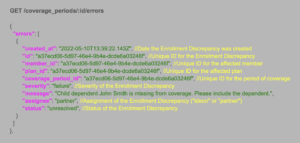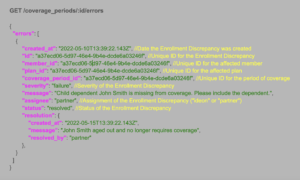Ideon Blog
February 08, 2023
By: Jashan Ahuja
Error management with Ideon, Part 1: A centralized, consistent experience

By Jashan Ahuja
Group Product Manager – Enrollment
In Part 1 of a series detailing our enrollment API’s features and capabilities, Ideon’s product team examines error reporting and management — how it works, what benefits platforms can expect, and the advantages of a centralized workflow.
Historically, it’s been an operational and technical nightmare for benefits platforms to exchange group and employee enrollment information with medical and voluntary carriers. No matter the carrier’s method of data exchange — EDI, API, portals, etc. — getting data from platform to carrier was rarely a simple task.
But once connected, it’s smooth sailing, right? Not quite. As benefits platforms’ operational teams know all too well, sending data is only part of the equation. The carrier must accept and confirm the change, and that’s where things start to get really complicated. Usually, the biggest challenge is handling and rectifying enrollment data errors—every carrier sends discrepancies in a different format, and their error reports are rarely human-readable.
At Ideon, we’re powering a new era of connection between carriers and tech platforms. One that’s better, faster, and more secure than the industry status quo. In this blog, we explain Ideon’s error-handling features, from standardizing carrier error messages to resolving errors via API, and how they create a far more efficient and accurate enrollment experience.
What are enrollment discrepancies?
It’s hard to find someone with experience in benefits who doesn’t think that data errors and discrepancies are a problem. Some examples include account set up issues, incorrect employee demographic information (social security number, birth date, etc.), coverage date errors, and more.
Today, most carriers report errors in non-standard formats, often via email and spreadsheets. These reports are usually delivered on a weekly basis, and the information they contain is rarely easy to understand. The result is a slow, manual, and resource-intensive error-handling process that poses a challenge to benefits platforms and their operations teams.
What’s the impact?
We analyzed the data from hundreds of groups and thousands of members and found that about 8% of employee enrollments have a critical coverage issue, i.e. incorrect coverage dates, plan information, or birth date, or they’re missing entirely from either the carrier or platform system. Importantly, more than 80% of groups with 20+ members have critical errors.
And these errors have significant ramifications for the entire benefits ecosystem – from carriers and benefits platforms, to brokers, employers, and employees. The downstream impact ranges from lost revenue and broker commissions, to operational inefficiencies and employee experience issues.
Carriers are missing out on millions in potential premium. In one recent migration of about 200,000 employees onto the Ideon platform, our technology identified errors resulting in nearly $1 million in lost premium for the carrier.
For the employers in that migration, we saved more than 30K employees from potential coverage issues — all from one migration of approximately 200K lives. Ultimately, inaccurate data can cause serious problems for employees. Everyone in our industry can relate to the countless access-to-care issues that occur during open enrollment because of erroneous data. Or, imagine a life insurance claim for an employee who wasn’t enrolled accurately — there would be an emotional and financial impact on a grieving family, while the employer and platform would likely suffer reputational harm.
For a detailed look at how inaccurate data impacts every benefits industry stakeholder, read this recent blog by Ideon CEO Michael Levin.
Enrollment discrepancies via Ideon
The processes outlined above remain the industry status quo: manual error handling through spreadsheets and emails, inconsistent carrier formats, and a barrage of harmful errors that affect all stakeholders.
At Ideon, we’ve developed a revolutionary alternative for benefits platforms where enrollment discrepancies are centralized, standardized, and actionable. Here are three ways our solution differs from the typical process:
- Many-to-one – Ideon translates all of the enrollment “errors” generated by carriers into a uniform and ingestible format.
- Standardized messaging – Each enrollment discrepancy has a “message,” which is a standardized version of the carrier error translated into a human-readable format.
- Centralized communication – Benefits platforms view and resolve all enrollment discrepancies, from multiple carriers, directly through Ideon’s API endpoint, allowing for a streamlined and centralized user experience and eliminating the need for other communication (e.g. e-mails and slack messages).
Centralized error management via Ideon’s API
Ideon’s error reporting solution helps platforms prioritize and rectify discrepancies by providing insight into the severity of each discrepancy and who’s responsible for fixing it. Regardless of the carrier or the original data source, platforms get a consistent, simple API experience.
In this section, we examine Ideon’s key error management features and highlight how platforms interact with our API.

Severity – For each enrollment discrepancy we expose a Severity (“Info”, “Warning”, or “Failure”) that highlights the impact of the issue. A “Failure” enrollment discrepancy indicates a blocker to a member’s enrollment, whereas “Info” and “Warning” enrollment discrepancies provide visibility into informational updates or future changes required, for example when a dependent is due to age out in a couple of months.
Assignment – Each enrollment discrepancy has a Responsible Party and can be assigned to “Ideon” or “Partner”. This provides visibility into enrollment discrepancies that are currently being managed by our Enrollment Operations team and allows users to easily identify enrollment discrepancies that they need to address.
Status – Enrollment discrepancies have a status of “Unresolved”, “Resolved”, or “Returned”. This allows our teams to stay in-sync on each individual enrollment discrepancy. When we initially surface an enrollment discrepancy, it is in an “Unresolved” status. The status is updated to “Returned” when any comments are added and “Resolved” when a resolution message is provided.
Resolution – Partners are able to add a resolution message to an enrollment discrepancy via a simple API endpoint. This updates the status of the enrollment discrepancy to “Resolved”. If the issue still remains when the carrier re-attempts to process the data then the enrollment discrepancy can be reverted back to an “Unresolved” status so the history is retained.
Comments – Partners are able to interact with our operations team entirely via the enrollment discrepancies API endpoint by threading comments directly on the original enrollment discrepancy. This allows for efficient interaction between our respective Operational teams without needing additional tools or e-mails.
API and webhook transmission – Partners can pull down enrollment discrepancies directly from our API via a GET endpoint. We also provide enrollment discrepancies via Webhooks or a standard periodic CSV report.

In summary, managing and rectifying enrollment data errors and discrepancies is a critical aspect of the benefits workflow. At Ideon, we understand the pain points of the industry and have developed a solution that streamlines the process by: standardizing error messaging; delivering a centralized resolution experience for benefits platforms; and helping them prioritize and, ultimately, resolve each discrepancy. Platforms can easily manage enrollment discrepancies, from multiple carriers, directly through our API endpoint, allowing for a streamlined experience without back-and-forth email communication.
Coming soon — Part 2: Auto reconciliation overview
Standardizing errors is a big step forward, but did you know Ideon can proactively identify them whether or not the carrier actually reports them? In the next blog in this series, we’ll dive into Ideon’s auto reconciliation feature, an industry-first capability that automatically compares data in the carrier and platform systems, surfacing discrepancies in near real-time.


